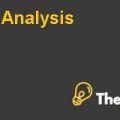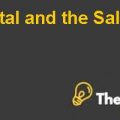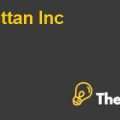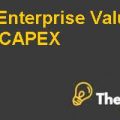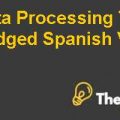Marriott Corporation The Cost Of Capital Case Study Analysis
1. Introduction:
The case presents a company, named “Marriott Corporation” (MC), possessing an attractive and well known position in the hotel industry, providing services broadly categorized into three divisions; lodging, contract services and restaurants. It was established by J. Willard Marriott in 1927. Dan Cohrs, vice president of MC’s project finance, is preparing his annual recommendations for the hurdle rates at each of the firm's three divisions.
Finance division evaluates investments using “Weighted Average Cost of Capital” (Wacc) as a hurdle rate to discount the cash flows for an investment opportunity. This Wacc is calculated from two subgroups; cost of equity and cost of debt, giving appropriate weightage to each group.
2. Problem Statement:
Following points need to be analyzed;
- What risk-free rate and risk premium should be used for cost of equity?
- How does the cost of debt for Marriott should be calculated.
- Determine weighted average cost of capital (Wacc) for Marriott Corporation, and the three lines of business.
- What type of investments should be evaluated using Wacc of MC.
- If a single Wacc is used for all lines of business, what would happen.
- How can cost of equity be estimated without comparable public companies.
3. Analysis / Result:
Let us consider and analyze the above mentioned points. Also refer to the Excel Sheet – Marriott;
What risk-free rate and risk premium should be used for cost of equity:
To increase shareholder value MC use shareholders' measure to estimate the cost of equity, which is Capital Asset Pricing Model (CAPM). According to the CAPM, the cost of equity is found by;
Cost of equity = (equity / capital) x [ Risk free rate + (Beta x Risk premium) ]
Risk free rate is the rate of return expected from high grade secured investments which are considered the safest, as returns on Treasury bills, U.S. government bonds, and high-grade, long-term corporate bonds. Risk premium is the difference between the expected return on a market based portfolio and the risk-free rate. Thus the for the risk premium, spread between the market based portfolio of S&P 500 Composite returns and the holding-period returns on Treasury bills, U.S. government bonds, and high-grade, long-term corporate bonds is used.
For the purpose of determining the period to be compared for risk free return and risk premium, investment life of the project should be considered. Because lodging assets, like hotels, had long useful lives, return on long-term government bonds should be used for lodging calculations, which should be from the period 1926 to 1987 (exhibit 5 of the case) as this effectively reflects the bottom line nature of return with a long term view including all abnormalities during this period. Short term returns on Treasury Bills should used as basis for restaurant’s and contract services division’s risk free rate and risk premium because those assets had shorter useful lives. This should also be the from 1926-1987 (exhibit 5 of the case).
Use of returns can be either arithmetic average or geometric average but geometric average is more appropriate then arithmetic average as arithmetic average is reflecting simple return over a period of time on initial investment, irrespective of the capital gain from period to period. However, geometric average shows compound return, which makes balance of investment value of previous year a principle base for calculation of next year’s return i.e. CAGR (compound average growth return). A capital investor is actually interested in the net return gained year after year, thus use of geometric is more appropriate. Hence we would use geometric average for risk free rate and risk premium for each of the three divisions, as given in exhibit 5 of the case.
Therefore, Risk free rate and risk premium for the three divisions are;
- Lodging: Risk free rate is geometric average of Long term Government bonds rate during 1926-1987 which is 4.27%. Risk premium is the geometric average of spread (exhibit 5 of case) between Long term Government bonds rate and S&P return during 1926-1987 which is 5.63%.
- Contract services and restaurants: Risk free rate is geometric average of Short term Treasury Bills rate during 1926-1987 which is 3.48%. Risk premium is the geometric average of spread (exhibit 5 of case) between Short term Treasury Bills rate and S&P return during 1926-1987 which is 6.42%.
How does the cost of debt for Marriott should be calculated:
Cost of debt is calculated by;
Cost of debt = [debt / (debt + equity)] x [(1- tax) x debt servicing cost].
The two inputs are thus the debt ratio in total capital and the applicable debt servicing cost. The cost of debt for all the divisions of MC is calculated using the below two inputs;
- Overall Debt component for all the divisions of MC in its total capital is which is 74%, 40% and 42% for lodging, contract and restaurant divisions (Table A).
- Overall Cost of Debt servicing for each division of MC is a mixture of floating rate and fixed rate. These debt servicing costs are 1.10%, 1.40% and 1.80% above the government rate for lodging, contract and restaurant divisions, to induce investors to lend money to Marriott. Lodging possess long term debt (due to lodging business assets are of long term nature i.e. 30 years versus the short term divisions of contract service 10 years and much more shorter life for restaurants, which possess assets of more short term nature i.e. 1 years. Therefore government rate for 30, 10 and 1 year bond is used from Table B, which is used with respective spreads to arrive at the debt servicing cost of 10.05% for lodging, 10.12% for contract services and 8.7% for restaurants.
Using the tax rate (found by tax expense for 1987 versus income before tax) of 44.1%, respective debt levels and debt servicing costs, the debt cost for each of MC’s division is found to be 4.16%, 2.26% and 2.04%.
Thus, for estimating overall debt cost for MC, average of the individual debt costs of each of the division is taken. Using this method, the overall debt cost for MC is found to be 2.82%...
Marriott Corp Cost of Capital Case Study solution
Marriott Cost of Capital Valuation
Comparing the rate of your Marriott Hotels to that of the traditional hotels may seem like a useless exercise, but you need to consider the long-term benefits that a simple valuation will give you. When it comes to making long-term investment decisions, you need to always think about long-term benefits and not just short-term gains. A valuation will give you great insights to figure out what your true capital gains are with your investments, giving you a chance to make better decisions.
If you invest in a business, you usually expect a profit in the future. You will also invest in a hotel for the same reason, to get a profit in the future. If you own a Marriott Hotel today, you can now determine what your book value would be if you were to sell it.
First, you need to find out how much your book value is when you go in the business. This book value is the sum of all costs that were incurred during the year to purchase the property, add up all of the costs associated with constructing the building, then add in all of the mortgage interest charges as well as maintenance costs over the years. By doing this math, you will know exactly how much your valuation is.
You have two ways to look at the Capital appreciation and depreciation of the property. One way is the traditional and logical way. You look at the amount of changes that have occurred in the market. This is the same methodology used by people who buy real estate; they purchase the properties at fair market value and get paid for them at a higher price because of inflation.
The traditional method is not accurate because in the current market, properties have a lot more depreciation that does not go into account. The second way to look at the difference between the book value and the realized value is by considering the lower percentage depreciation and the higher expenses. You can see the increase in the expenses, but not in the gross profit. So when you buy a new Marriott Hotel for $100 million, you could buy it for less than half that if you considered the expenses and book value. The book value will represent your true appreciation in the business, and the higher expenses are taken into account, the better it will be for you to make the best investment decision.
Once you have figured out the expenses and book value, you have to figure out the Capital appreciation. The Capital appreciation is the difference between the estimated price and the actual price at the end of the year. This is basically the difference between the gross profit and the book value. Again, the reason why you need to use this methodology is because there is a lot more depreciation in the market today.
For instance, while vacation homes and commercial properties have very little depreciation, most real estate does have a significant amount of depreciation. Therefore, if you had to subtract out all of the depreciation to get your net book value, you will discover that your real estate valuation is significantly lower than that of a Marriott Hotel.
When you use a discounted cash flow valuation (DCF) and the Net Present Value (NPV), you will discover that the NPV is more accurate than the DCF. Using a discounted cash flow valuation is like using a spreadsheet and computing your net present value, while the DCF uses a formula that you can't replicate easily on your own.
To figure out the price, you will need to estimate the net present value of the taxes paid on the property. Of course, you cannot just project the tax liability for the next ten years and then make a projection on the capital gain. The correct method is to make projections based on the current tax code, then project the expenses.
Then, with all of these expenses and the Projected cash flow, you estimate your return on the property. You should also include depreciation and amortization (depreciation) in your estimate, because it is capital improvements that pay off over time. and amortization is just the incremental cost of your improvements over time.
Mariott Hotels Case NPV
In any type of hotel, the management fees are usually higher compared to the cost of capital. The higher the NPV, the lower the overall cost. This is why most traditional real estate operators prefer properties that have a higher NPV.
For Marriott, the cost of capital is the total of the management fee and operating fee. The three main operating costs are the cost of construction, investment and depreciation.
After the five years of occupancy, these fees are offset by the income from the rent, plus a profit for the loss component, and some other expenses are included. As a result, the real estate operator does not gain from the occupancy.
Once the five years are over, the capital will be paid in two forms: the first is a cash outflow from the Marriott properties, and the second is an equivalent return. Even if the property stays in the same form, the second option is often preferred.
The NPV, however, does not take into account the depreciation since it is the cost of capital. However, this is part of the long-term management fee, which also includes the maintenance fee and the depreciation element.
In most cases, the short-term management fee is associated with an additional percentage of appreciation, known as the IRR. The IRR is simply the difference between the long-term management fee and the long-term rent. While this may sound like a big difference, the fact is that it represents a negligible portion of the overall cost of management.
One more factor that has a direct impact on the overall cost of ownership is the management fees. These are the charges that Marriott hotels collect from their guests at the time they stay in the hotel. These management fees are not really taxes but are an incentive to keep the guest's rooms occupied.
The management fee is lower than the operation and depreciation costs. As a result, the overall cost of ownership is higher compared to the capital. Therefore, the overall cost of management is typically lower than the capital costs.
Management fees can also include long-term maintenance. Even when the hotel is sold, these fees can still be built into the price. This allows the new owner to get a fair price without considering these maintenance costs.
As in any hotel, the management fee will probably not be exactly equal to the capital cost. The management fee is usually tied to the hotel's profit. However, the hotel's income will be smaller compared to the capital so the management fee is often higher.
However, this is expected to change as the hotel appreciates in value, since the management fee represents the current value of the property. Therefore, the annual fee will also be higher than the management fee.
Most hotel operators will only focus on the present value of the properties, or the NPV. They do not usually consider the long-term maintenance fees, which has a huge impact on the long-term maintenance cost of the hotel.
Marriott Hotels Cost of Capital Case Analysis
Are you looking for a case study about Marriott hotels? Then this article is sure to help you. For the sake of this article, we are going to look at the total occupancy percentage.
According to its annual report, the average occupancy percentage of the Marriott properties is 84%. So what does this number mean?
This figure refers to the number of rooms that can be filled during the year. Now, let's analyze what Marriott hotels really mean when it comes to guest satisfaction. We need to be able to answer some basic questions before we can find out whether or not this type of occupancy is good. And by answering these questions, we will be able to gauge the overall satisfaction of guests.
First of all, we need to know the quality of service. Even though Marriott hotels have excellent value, the majority of customers still want to see greater value. They want to see exceptional customer service.
Another thing to consider is customer service. If you are receiving excellent customer service in your hotel, then you are probably getting what you pay for. After all, if the hotel has low quality service, the guests won't stay. They will probably go elsewhere.
The janitorial services and the availability of facilities are also important to evaluate. Since these things are usually provided free in most hotels, it means that the hotel is giving you a lot for the money that you spend.
The next thing to think about is the availability of rooms during the peak season. The fact that the hotels are able to accommodate a huge number of people during the busy times means that they have higher total occupancy rate than the normal times.
The third thing to look at is the quality of the rooms that the hotel provides. The actual number of rooms that you get might not be all that it is cracked up to be. You need to know the type of mattress that you will be sleeping on, the comfort level that you should expect from the bed, the type of linens that are available, and the types of room accessories.
In this case analysis, we are not dealing with customer service. We are just going to analyze the overall satisfaction of the guests with the hotel.
Marriott is a part of the resort hotel companies. Most of them do not provide the hotel with free rooms, which means that the price of the rooms does not come free.
In this case analysis, we are not going to focus on the actual amenities of the hotel. However, if we are going to include the amenities and the standard of living provided, we should keep in mind that the hotels do provide some basic amenities.
In the end, this case analysis will give you an idea on what to expect when you book your trip to a Marriott. In fact, this case study can also help you determine the hotel that would best suit your needs. By analyzing this case study, you will be able to see if a hotel that offers similar amenities and standard of living would be more appropriate.
This is just a sample partial case solution. Please place the order on the website to order your own originally done case solution.


